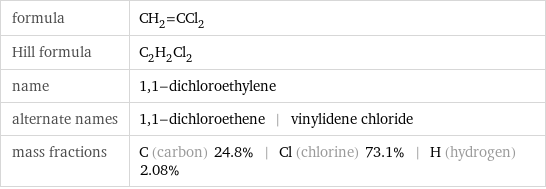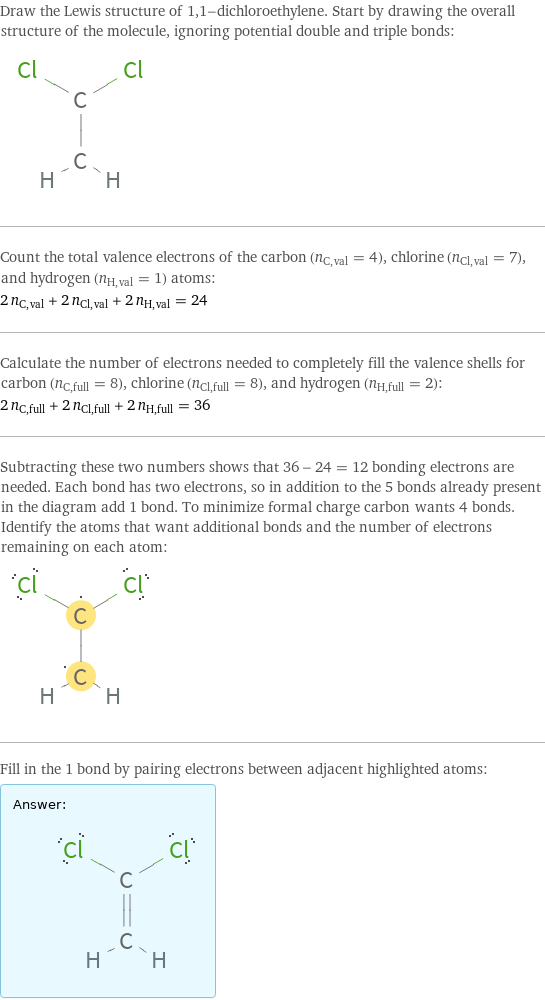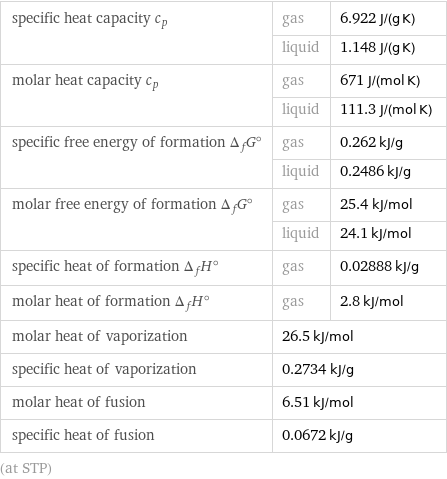Input interpretation

1, 1-dichloroethylene
Chemical names and formulas

formula | CH_2=CCl_2 Hill formula | C_2H_2Cl_2 name | 1, 1-dichloroethylene alternate names | 1, 1-dichloroethene | vinylidene chloride mass fractions | C (carbon) 24.8% | Cl (chlorine) 73.1% | H (hydrogen) 2.08%
Lewis structure

Draw the Lewis structure of 1, 1-dichloroethylene. Start by drawing the overall structure of the molecule, ignoring potential double and triple bonds: Count the total valence electrons of the carbon (n_C, val = 4), chlorine (n_Cl, val = 7), and hydrogen (n_H, val = 1) atoms: 2 n_C, val + 2 n_Cl, val + 2 n_H, val = 24 Calculate the number of electrons needed to completely fill the valence shells for carbon (n_C, full = 8), chlorine (n_Cl, full = 8), and hydrogen (n_H, full = 2): 2 n_C, full + 2 n_Cl, full + 2 n_H, full = 36 Subtracting these two numbers shows that 36 - 24 = 12 bonding electrons are needed. Each bond has two electrons, so in addition to the 5 bonds already present in the diagram add 1 bond. To minimize formal charge carbon wants 4 bonds. Identify the atoms that want additional bonds and the number of electrons remaining on each atom: Fill in the 1 bond by pairing electrons between adjacent highlighted atoms: Answer: | |
3D structure

3D structure
Basic properties

molar mass | 96.94 g/mol phase | liquid (at STP) melting point | -122 °C boiling point | 31 °C density | 1.213 g/cm^3
Units

Liquid properties (at STP)

density | 1.213 g/cm^3 vapor pressure | 500.5 mmHg
Units

Thermodynamic properties

specific heat capacity c_p | gas | 6.922 J/(g K) | liquid | 1.148 J/(g K) molar heat capacity c_p | gas | 671 J/(mol K) | liquid | 111.3 J/(mol K) specific free energy of formation Δ_fG° | gas | 0.262 kJ/g | liquid | 0.2486 kJ/g molar free energy of formation Δ_fG° | gas | 25.4 kJ/mol | liquid | 24.1 kJ/mol specific heat of formation Δ_fH° | gas | 0.02888 kJ/g molar heat of formation Δ_fH° | gas | 2.8 kJ/mol molar heat of vaporization | 26.5 kJ/mol | specific heat of vaporization | 0.2734 kJ/g | molar heat of fusion | 6.51 kJ/mol | specific heat of fusion | 0.0672 kJ/g | (at STP)
Chemical identifiers

CAS number | 75-35-4 Beilstein number | 1733365 PubChem CID number | 6366 PubChem SID number | 24850019 SMILES identifier | C=C(Cl)Cl InChI identifier | InChI=1/C2H2Cl2/c1-2(3)4/h1H2 RTECS number | KV9275000 MDL number | MFCD00011653
Safety properties

flash point | -22.78 °C
Toxicity properties

threshold limit value | 5 ppmv

long-term exposure limit | 40 mg/m^3 (over 8 hours)